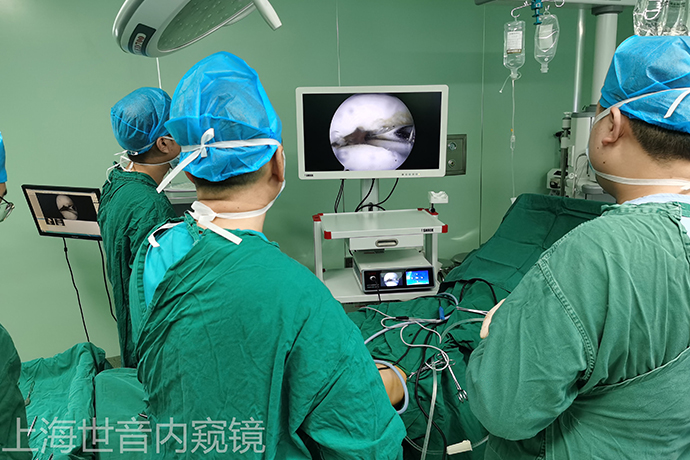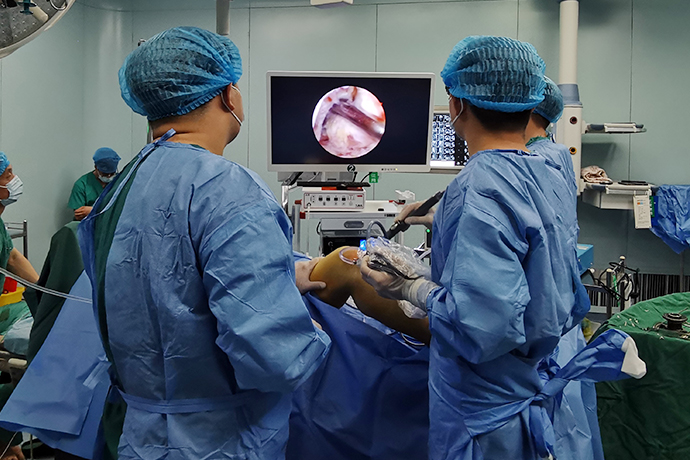【Orthopedic Arthroscopy】Common Methods of Knee Joint Puncture
Release time: 12 Jul 2022 Author:Shrek
Knee arthrocentesis is often used to check the nature of the fluid in the joint cavity, or to inject medicine into the joint cavity after the fluid is drawn. Fluid in the knee joint cavity needs to be treated by arthrocentesis or drainage, or by injection of drugs. An arthrography is performed by injecting air or a contrast agent into the joint cavity to see changes in the articular cartilage or bone ends.

The knee joint capsule, ligament and tendon attachment point, the nerve distribution is relatively dense. Many nerve branches penetrate deep into the cartilage, synovium, and subchondral vessels within the knee joint cavity. Many unmyelinated nerve ending receptors also co-distribute with vascular courses in the joint capsule, synovium, and joint fat pad.
Causes of knee joint effusion:
1. Injured (sports-related) knee sprain, meniscus injury, collateral ligament or cruciate ligament injury.
2. Infection (tuberculosis).
3. rheumatoid arthritis, synovitis.
Body position: supine position, muscle relaxation
Joints: straight or slightly flexed
Needle entry point: around the patella or at the eye of the knee
When joint degeneration, excessive exercise or trauma, the lactic acid, histamine, bradykinin, prostaglandin and neuropeptide in the joint cavity are activated, which can cause pain, and at the same time, a large amount of joint effusion occurs in the knee joint cavity, pressure Increased, swelling of the knee joint.
positioning method
1. Take the center point of the patella as a horizontal line and a vertical line. The first and second quadrants of the patella are each bisected by a 45-degree angle. The intersection of the bisector and the inner and outer edges of the patella is the needle insertion point.
2. The patient is in a supine position, the knee joint is straight, the intersection of the upper border of the patella and the medial and lateral border of the patella are two points, obliquely to the center of the patellofemoral joint, and puncture at an angle of 45°.
3. The knee joint is slightly flexed about 30°, and the needle is inserted vertically from the medial or lateral joint space of the patellar ligament below the patella.
puncture of the lateral superior border of the patella
Location: at the junction of the lateral superior border of the patella and the vastus lateralis. Press the depression under the vastus lateralis muscle, stick the nail to pierce 0.5-1cm, and feel the drop.
advantage:
1. Less nerve distribution, less sensitive, thin tissue, good feel. The patient is easy to cooperate.
2. There is less synovium in the joint, which is not easy to cause pain. The puncture site has less tissue, and the needle can easily reach the joint cavity. Close to the suprapatellar sac, the fluid in the suprapatellar sac can be squeezed down, so that the fluid extraction is more thorough, and the needle moves up to directly extract the fluid in the suprapatellar sac.
The puncture of the lateral inferior border of the patella (lateral knee eye)
Positioning: The knee is flexed 90°, the lower border of the patella, 1cm lateral to the patellar ligament (the outer knee eye, a small depression can be seen).
Method: After positioning with nails, disinfect the affected area, the needle is parallel to the tibial plateau, at a 45-degree angle inward, puncture and enter, and the needle can be completely pierced.
Advantages (knee eye):
1. Better positioning, no pain after joint injection. The patient is easy to cooperate.
2. The injection of sodium hyaluronate through the lateral joint cavity of the patellofemoral joint can avoid pain caused by the injection of the drug into the infrapatellar fat pad and affect the efficacy of the drug.
3. The needle is inserted from the upper side of the patella, and the needle can also be inserted from the medial edge gap, and the effect is also good. If the synovial membrane hyperplasia is severe and the infrapatellar fat pad is too thick, it is not easy to insert the needle, but it is easy to repeatedly stimulate the synovial membrane and the fat pad to cause pain.
Precautions
1. The puncture instrument and operation must be strictly sterile to prevent secondary infection of sterile joint cavity exudate. Routine disinfection and burrowing were performed, local anesthesia with 2% lidocaine was used, and the drugs to be injected were prepared before the operation, and the patient was relaxed during the puncture.
2. Carefully select the puncture point first. The puncture point should avoid blood vessels, nerves, tendons, skin lesions or superficial parts, and easily enter the joint cavity. During the operation, the operator's fingers should not touch the skin and needle point of the needle insertion point. The movement should be gentle, do not penetrate too deep, to avoid damage to the articular cartilage.
3. The speed of the puncture needle entering the skin should be fast. Gently withdraw the needle and push the needle forward until the synovial fluid appears. If the puncture encounters bony obstruction, it is advisable to withdraw the needle a little or slightly change the puncture direction, and then insert the needle while suctioning; insert the needle while suctioning during puncture, if it is suddenly found that there is infection outside the joint capsule. For fluid or pus, the needle should be stopped immediately; it is best to first perform antibacterial treatment on the infected area of the soft tissue that has been punctured. The relationship of the joint cavity must not be easily entered into the joint cavity. After the puncture is completed and the needle is removed, the puncture site should be disinfected with iodine.
4. If there is too much joint effusion, apply appropriate pressure to fix the bandage after suction. If there is a lot of fluid, it is generally possible to puncture twice a week.
5. The needle should be inserted while suctioning, paying attention to whether there is fresh blood. If it is indicated that the blood vessel is pierced, the puncture needle should be withdrawn a little, and the needle should be continued after changing the direction.
6. Repeated injection of steroids in the joints can cause joint damage. Therefore, any intra-articular injections of steroids should not exceed 3 times.
7. In addition to microscopic examination, bacterial culture and drug susceptibility test (antibiotic susceptibility test), the extracted liquid should also be carefully observed with the naked eye to preliminarily determine its properties and give timely treatment. Normally, it is straw-yellow, clear and transparent. If it is dark red and old blood, it is often traumatic; if the blood drawn contains fat droplets, it may be an intra-articular fracture. The cloudy liquid indicates infection. Diagnosis is certain.
8. Do not touch the water at the needle eye within 6 hours after puncture, and do not apply external medicine within 48 hours. Patients receiving anticoagulant therapy should be immobilized for 1-2 days, and if necessary, ice cubes and elastic bandages can be applied near the joints to wrap the joints. Do not bathe locally for 3 days.
how to choose? Lateral inferior border of patella or superior lateral border of patella
(1) For patients with a large amount of effusion in the joint, use the needle at the lateral upper edge of the patella to extract the fluid, and then inject sodium hyaluronate by the way. Because when there is a lot of effusion in the joint, most of the effusion is in the suprapatellar capsule, and the patellofemoral joint space is also relatively large. It is easy to operate the needle at the lateral upper edge of the patella, and the effusion can also be extracted. For patients without joint effusion, needle insertion at the lateral superior border of the patella is not easy to operate.
(2) For patients without joint effusion, the puncture method of the lateral lower edge of the patella (lateral knee eye) must be used, and the position must be determined (the knee is flexed 90 degrees, the lower edge of the patella, 1 cm lateral to the patellar ligament), and an 8-gauge needle is used. It is parallel to the tibial plateau, at a 45-degree angle inward, the needle is completely pierced, and there is a sense of disappointment. Sometimes the joint fluid will be drawn out, and the injection can be assured at this time; if the joint fluid is not drawn out, sodium hyaluronate can be injected. If the injection is relatively easy, then there is no problem. If the injection is laborious and the patient feels pain and swelling, the needle can be further inserted into it and moved left and right. The injection is relatively easy, and the patient can inject again without discomfort. As long as skilled operation, correct positioning, and timely adjustment, patients rarely experience discomfort after injection.

- Recommended news
- 【General Surgery Laparoscopy】Cholecystectomy
- Surgery Steps of Hysteroscopy for Intrauterine Adhesion
- [Gynecological Hysteroscopy] Techniques for Preventing and Treating Complications of Hysteroscopic Surgery
- [Gynecological Hysteroscopy] Hysteroscopic Adhesiolysis
- [Gynecological Hysteroscopy] IUD Removal under Hysteroscopy